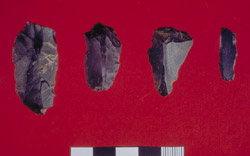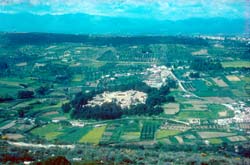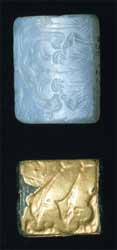Prehistory in Crete: an overview
 Chert assemblage from Troulos. © Sphakia Survey |
As far as we can tell, the first people arrived on the north coast of Crete in the Stone Age, or Neolithic period, ca. 6000 BC.
 Double-axe, from above. Ashmolean Museum (inv. 1910.183). Courtesy of the Ashmolean Museum, University of Oxford. |
They lived in small farming settlements and by the end of Neolithic period (ca. 3000 BC) had reached all parts of the island. In the Bronze Age, also known as the Minoan period, people began to use metal, particularly the copper alloy(s) that gives the period its name.
 Knossos from Ailias, spring 1985. © Lucia Nixon |
Social stratification emerged in the Early Minoan period (3100 - 2100 BC), and crystallised towards the beginning of the Middle Minoan period (2100 - 1600 BC), when the first monumental complexes known as palaces were constructed (the First Palace period, 1900-1700 BC). The second palaces were built and used in 1700-1450 BC. Knossos, Malia and Phaistos are the three sites with both old and new palaces. In Unit 3 we will look in some detail at Knossos.
Foreign contacts with Egypt and the Near East, as well as the Greek mainland, were important and influential in this period. These connections can be seen in the Egyptian and Near Eastern objects found on Crete, and in the Aegean-style wall-paintings found in Egypt and in the area of modern Syria.
 Two sealstones. Ashmolean Museum (inv. 1938.955 [blue], 1938.963[gold]). Courtesy of the Ashmolean Museum, University of Oxford. |
The Minoans used various forms of record-keeping: seals, sealings, and scripts, of which the most important were Linear A and Linear B.
 Linear B tablet (K (1) 872) from Knossos. Ashmolean Museum (inv. ae.2031). Courtesy of the Ashmolean Museum, University of Oxford. |
Linear A is an undeciphered script used in the Second Palace Period. Linear B was used to write an early form of Greek, and was used in the Third Palace Period (1450 - 1200 BC), when the administration of Crete seems to have been linked with that of the Mycenaean Greek mainland.
We shall look more closely at a Linear B text in Session 4.
At the end of the Bronze Age, in the Late Minoan period which runs from 1600 to 1050 BC, the Minoan palaces on Crete and the Mycenaean palaces on the Greek mainland ceased to function, though foreign contacts with the Near East and the Greek mainland remained important.